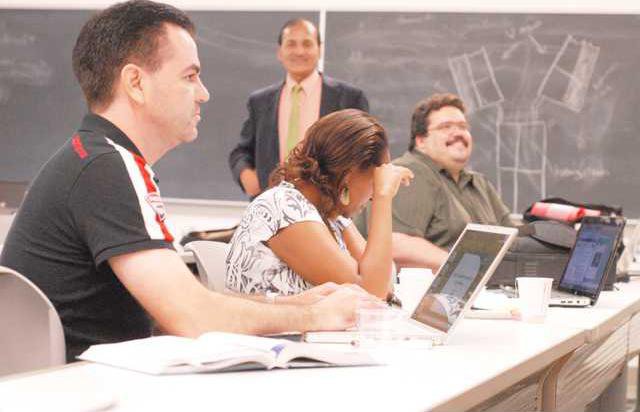Busy business people oftentimes need an advanced degree – the notorious Masters of Business Administration – to move ahead in their competitive careers.
But with families, personal responsibilities, and 8 to 5 – or longer – work schedules, many businesspeople find it hard to make time to earn that needed degree.
The problem is well known to Ashour Badal, director of the California State University, Stanislaus Executive MBA program, which caters to just that segment of students.
“For a long time, we had adult learners and professionals who were very busy with their traditional professional schedule and their families come to us,” Badal said. “For a long time they had been asking us for a program that is tailored around their schedule.”
About five years ago, Badal led an fact-finding group to determine just what an MBA program targeted at that demographic might look like, polling professors, businesses, and potential students. The end result was an Executive MBA degree program dedicated to busy professionals in every way, going as far as to offer a “concierge,” who manages everything from financial aid to registration for students.
In-person classes, which account for about 70 percent of the program, meet only on Saturdays, allowing students to work during the week. Flexible online classes make up the remaining 30 percent of instruction.
That schedule was a large part of the appeal to Allison Van Guilder, a 2009 graduate of the EMBA program who now works as the City of Turlock Parks, Recreation, and Facilities manager. She wanted to further her career, but had concerns about traditional class schedules.
“Having a full time job and being a mom, it made more sense to me to do this on a Saturday rather than be in night school,” Van Guilder said. “... I couldn’t imagine being in class until 10 p.m. and not being able to tuck my kids in.”
But the program was still a sacrifice, Van Guilder said, with every weekend in class and late nights and early mornings spent doing homework. The sacrifice was worth it though, she said, with a fantastic group of professors and working professionals as classmates who brought their own experiences to the classroom.
“When we were discussing an issue it wasn’t just based on the text, it was a real-life experience we could all share and learn from,” Van Guilder said.
When Van Guilder attended the program, the class met at Turlock City Hall, but the site for in-person classes changes with each cohort, moving from Turlock to Tracy and Stockton to cater to local professionals. Oftentimes those classes meet at employer sites, with past cohorts meeting at the City of Tracy, and the Stanislaus County Workforce Alliance, providing additional networking opportunities.
“The degree gets you on the train, but to get from destination to destination takes professional networking,” Badal said.
To further build professional connections, the program pairs students with local businesses and agencies to help solve real-world problems.
In Turlock, EMBA students were responsible for researching the development of a downtown farmers market, which led to the market’s reopening last year. Another group of students researched downtown economic development. In Tracy, three students worked with the city to draft a plan to make Tracy “green,” with guidelines and cost estimates.
“It's not just a school project, it’s really something that they take quite a bit of pride in because they give back to their community,” Badal said.
The real-world focus of the program extends beyond the class projects, with curriculum centering more on practical knowledge than abstract theories. Badal classified the program as focusing on strong leadership and strategic analysis, two items he says are important for business both today and in the long term.
The cohort-based program differs from a traditional MBA in that the degree is offered through the CSU Stanislaus Office of Extended Education, rather than the state-supported university proper. The EMBA is fully accredited, but students pay the full cost of their degree, with no state-funding assistance – $28,500 for the most recent cohort, compared to about $16,000 for a traditional MBA.
But the self-support program offers some benefits for the cost, Badal said, including an all-inclusive tuition which covers classes, books, and even meals during classes.
Unlike state-supported traditional MBAs, which do not guarantee students will be able to take all the classes they need to complete that two-year program in a timely manner, the EMBA guarantees a 15 month graduation time — if students follow the prescribed class schedule. That's important to professionals, Badal said, who need the security of a firm end date to commit to a program, and a shorter time to completion.
“People move around and change jobs,” Badal said. “They can't commit without knowing when they can finish the program.”
Despite the costs, the program has been an unqualified success thus far, Badal said, drawing students from as far away as Monterey, Oakland, San Jose and Fresno. The most recent cohort, which began Aug. 6 in Stockton, was one of the largest yet at 31 students.
“That's a testimony to what we're doing,” Badal said.
The start date for the next EMBA cohort has yet to be determined, but is expected in seven to eight months, with classes meeting in the Tracy or Modesto area.
For more information on the CSU Stanislaus EMBA program, visit www.extendeded.com/emba/
To contact Alex Cantatore, e-mail acantatore@turlockjournal.com or call 634-9141 ext. 2005.






